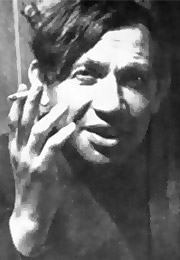


Oil on canvas
80.6 x 60.3 cm. (31 3/4 x 23 3/4 in.)
frame: 112.2 x 90 x 6 cm. (44 3/16 x 35 7/16 x 2 3/8 in.)
L.1988.62.27
Signed lower right: Soutine
[Lucien Lefebvre-Foinet Gallery, Paris]. Unknown party, known only as “R. N.”; sold to Redfern Gallery, London, by Jan. 1942; sold to Charles Collingwood, London, by Oct. 1942. [Feigl Gallery, New York, by summer 1948]; sold to Henry Pearlman, by 11 July 1949; Henry and Rose Pearlman Foundation, by 1971.
This woman with an anxious expression seems to wear the uniform of a maid or waitress. Soutine frequently painted people dressed in uniforms: bakers, bellhops, and choirboys. By 1929, however, he had become friendly with the Paris decorator Madeleine Castaing, who, with her husband, Marcellin, would become his major collector and primary means of support after the death of his dealer in 1932. In Mme Castaing’s milieu, the “little black dress” that Coco Chanel had introduced in the 1920s would have been considered chic, so this work might instead be a portrait of a paying client. Such ambiguity appears frequently in works by Soutine, who accorded equal attention to portraits of people in service and depictions of their employers.

Chaïm Soutine (1893-1943)
Soutine was one of the leading figures of the early 20th-century international conglomerate of artists known as the School of Paris. He developed an idiosyncratic style that was derived from his study of Old Masters and infused with a modern sense of freedom, conveyed through pure color and boldly impastoed paint. The artist’s intense painterly manner influenced subsequent generations of painters, including Abstract Expressionists.
Soutine was born to an Orthodox Jewish family originally from Belarus and grew up in a Lithuanian ghetto. He was attracted to drawing at early age, and, despite protests from those in his community who believed in Talmudic proscriptions against images, he was determined to become an artist. He studied at a small academy in present-day Vilnius, where he learned about Russian art, including its avant-garde varieties. In 1913, Soutine moved to Paris, where he joined Fernand Cormon’s atelier. He found inspiration by studying in the Louvre directly from Old Masters such as Rembrandt, Tintoretto, Goya, and El Greco, as well as more recent masters such as Gustave Courbet.
In 1915, Soutine met Amedeo Modigliani through their mutual friend Jacques Lipchitz and soon became close to the Italian artist. Modigliani provided crucial encouragement to Soutine and included him in his infamous drinking sessions. As it was for Modigliani, portraiture was a significant subject for Soutine. The artist’s portraits often exaggerate certain features, including awkward poses and melancholy facial expressions, imparting an expressive urgency to his subjects. He sometimes worked on series of certain social types, making a number of versions of figures such as pastry cooks, bellboys, and choirboys dressed in their identifiable working clothes. The pathos evoked by such figures often suggested not only the subjects’ inner lives but also the weight of Soutine’s own gaze and feelings.
Soutine applied a similar kind of painterly intensity to his still-life paintings of food, which are often inflected with ritualistic overtones that allude to the artist’s religious upbringing, as well as traditional memento mori themes that relate to his own experience of enduring shortages of food while growing up. In 1918, Soutine was apparently encouraged by his dealer to travel to the Midi to pursue landscape painting. In Céret and its environs he painted dramatically contorted scenes of the land and towns. These paintings often had a visionary quality, featuring vortex-like spatial configurations and forceful brushwork. In 1923, the American collector Albert Barnes purchased approximately one hundred examples of Soutine’s work, bringing a sudden rise in prices and greater critical visibility, which allowed Soutine to support himself through his art for the rest of his life. During his final years, however, he suffered both from illness and from the consequences of hiding from the Nazis during their occupation of Paris and died of complications from surgery before the war was over.